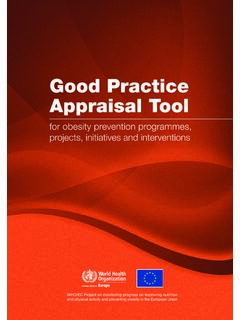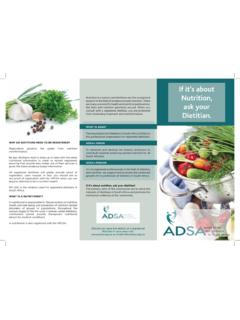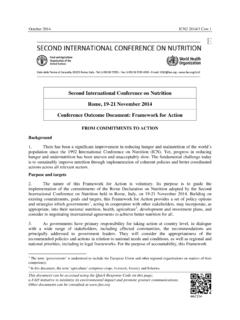Transcription of NGERIAN TRADITIONAL FOOD SYSTEMS and Nutrition …
1 NIGERIAN TRADITIONAL food NIGERIAN TRADITIONAL food system AND Nutrition system AND Nutrition SECURITYSECURITYPROF. IGNATIUS ONIMAWO (PhD)PROF. IGNATIUS ONIMAWO (PhD)BIOCHEMISTRY DEPARTMENTBIOCHEMISTRY DEPARTMENTAMBROSE ALLI UNIVERSITY, EKPOMA, NIGERIAAMBROSE ALLI UNIVERSITY, EKPOMA, Nutrition Society of NigeriaPresident Nutrition Society of NigeriaInternational Scientific SymposiumInternational Scientific SymposiumBIODIVERSITY AND SUSTAINABLE DIETSBIODIVERSITY AND SUSTAINABLE DIETSU nited Against HungerUnited Against Hunger33--5 November November TRADITIONAL food SYSTEMS refer to the human managed biophysical SYSTEMS that are involved in the production, distribution and consumption of food in a particular environment.
2 food SYSTEMS are a natural locus for improving Nutrition security in societies because agriculture is the primary employment sector for the ultra poor and because food consumes a very large share of the expenditures of the ultra poor. The causal mechanisms underpinning the poverty trap are clearly rooted in the food system that guides their production, exchange, consumption and investment behaviours. The most basic thing we know is that ill health, malnutrition and ultra poverty are mutually reinforcing states. The links are multidirectional. Low real incomes are the primary cause of chronic and acute hunger Even when food availability is adequate low incomes impede access to sufficient and appropriate food to maintain a healthy lifestyle.
3 Undernutrition, including micronutrient deficiencies, is the leading risk factor for disease and death worldwide, accounting for over half the disease burden in low income countries. Undernutrition also impedes cognitive and physical development, thereby depressing educational attainment and adult earnings . Disease, in turn, impedes the uptake of scarce nutrients, aggravating hunger and micronutrient malnutrition problems and hurting labor productivity and earnings . food SYSTEMS are the natural locus for developing an integrated strategy for addressing hunger, ill health and poverty jointly and thus assuring Nutrition security. Improvement in the food SYSTEMS have been found to greatly reduce hunger, improve income and reduce malnutrition and the related disease conditions in so many countries.
4 food security is closely linked to Nutrition security. Unacceptably high maternal, newborn and child mortality rates A woman s chance of dying from pregnancy and childbirth is 1 in 13 IMR is 75 deaths per 1,000 live births Child mortality is 88 deaths per 1,000 live births Overall under-five mortality rate is 157 deaths per 1,000 live births. Coverage of key interventions is low . Drop in EBF from 17 percent to 13 percent (NDHS 2008)Neonatal, 37%Pneumonia, 19%Diarrhea, 17%Malaria, 8%Measles, 4%HIV/AIDs, 3%Injuries, 3%Other, 10%Under- Nutrition (underlying cause)U-5 DEATHS Up to 1 million children die before the age of five. 50% underlying cause is under Nutrition . 26% are neonatal deaths (284,000).
5 Nutrition security is the access to adequate diet by every member of the household at all time. Access to food is tied to production of enough food by the agricultural system , income, cooking methods and house hold food sharing formula. Each of these factors is multifaceted such that an attempt to individually discuss them will be impossible within the scope of this ARE THESE TRADITIONAL food WHAT ARE THESE TRADITIONAL food SYSTEMSSYSTEMS These involve the methods and types of foods produced within the given community or state or country. In Nigeria the TRADITIONAL foods available are many and varied depending on climatic/agro-ecological zone. TRADITIONAL foods are foods produced locally which form part of the food culture inherent in the locality.
6 The local climate enables the cultivation of such crops either for subsistence or for income or both. food plants are TRADITIONAL in the sense that they are accepted by rural communities by custom, habit and tradition as appropriate and desirable food . People are used to them; they know how to cultivate and prepare them and enjoy the dishes TRADITIONAL food SYSTEMS CONTDTRADITIONAL food SYSTEMS CONTD They are grown for food within the farming SYSTEMS operating in any particular locality or gathered as wild or semi-wild products. There are two groups of foods: First, those consumed in the areas where they are grown as TRADITIONAL dietary staples, for example, cassava, yam, cocoyam, sweet potatoes (Ipomoea batatas), plantains (Musaparadisiaca) and maize.
7 The second group is made up of those consumed as a component of accompanying relishes and sauces. These include oilseeds, fruits and vegetables. Communities have evolved their own preferences and food habits overtime and will rather stick to what is food SYSTEMS CONTDTRADITIONAL food SYSTEMS CONTD A few questions naturally arise at this point What is the nature of the Nigerian TRADITIONAL food system ? What are the methods of food production in Nigeria? What are the TRADITIONAL foods in Nigeria? What are the nutrient compositions of TRADITIONAL Nigerian foods? Can the TRADITIONAL food SYSTEMS and the nutrient compositions assure Nutrition security? About 294 species and over 400 varieties of foods were documented in the South eastern part of Nigeria alone.
8 The foreign rice syndrome has in the recent past overtaken many households, especially in the urban areas. Twenty one (21) species of starchy roots and tubers, 20 legumes, 21 nuts/seeds, 116 vegetables, 12 mushrooms and 36 fruits have been documented in southern Nigeria. Cereals, starchy roots and tubers are important food groups for the majority of Nigerians. They are available all year round but are more abundant during the harvest season. Most commonly consumed legume in Nigeria is the cowpea (Vigna unguiculata). Local varieties of cowpea and other species of legumes are also available but not produced in very large quantities including bambara nut, African yam bean, ground nut, etc.
9 Mushrooms are also consumed though in relatively small quantities. Fruits are not main parts of the diet but are eaten outside regular meals. Two types of oil (red palm oil and vegetable oil- mainly ground nut oil) are commonly used. A total of 21 condiments and spices were identified. Some of these condiments are soup thickeners and are high in dietary fiber. Animal foods were about 27 species for meat/poultry/eggs, 12 species of fish and 3 species of insect/larvae were documented. The most popular game meats are grass-cutter, rabbit and antelope Milk and milk products not common food items except in the northern part of Nigeria. In all communities, foods are eaten not only for their nutritional values but also for their medicinal and socio-cultural , roastedede oku, edebuji, akpahuriCocoyamXanthosoma mafaffa(2 cvar.)
10 Used for soupAcharaMilletsPennisetum , milledOsikapa, iresiRice Oryza sativaMilled, boiledOsikapaRed riceOryza glaberrimaEaten as ripe fruitUnele, ogedeBananaMusa sapientum(many var.)Boiled, roasted, fried and made into flourosukwu,obuunu, ogedenokhuaPlantainMusa paradisiacalFermented for foofoo, boiled and sliced for dry chipsakpu nkola inuCassava (sweet and bitter types)Manihot esculenta(2 var.)Boiled, friedji nwa nnuPotatoes, sweet white, potatoes, yellowish redIpomoea batatas(2 var.)Boiled, roasted, fried, poundedjiocha,ji igweWhite yamDioscorea rptimdataBoiled ji okpuru, emhiYamDioscorea praehensilisBoiled ona,uno, otsinoThree leafed yamDioscorea dumentoriumBoiled, roasted poundedji oku, ochiokpoYellow yamDioscorea cayenensisBoiledadu, aduinuAerial yamDioscorea bulbiferaBoiled, pounded ji abana, ji mvulaWater yamDioscorea alataBoiled and pounded with cassavaCocoindia, nkpongnambing, okorokoCocoyamColocasia spp.

















